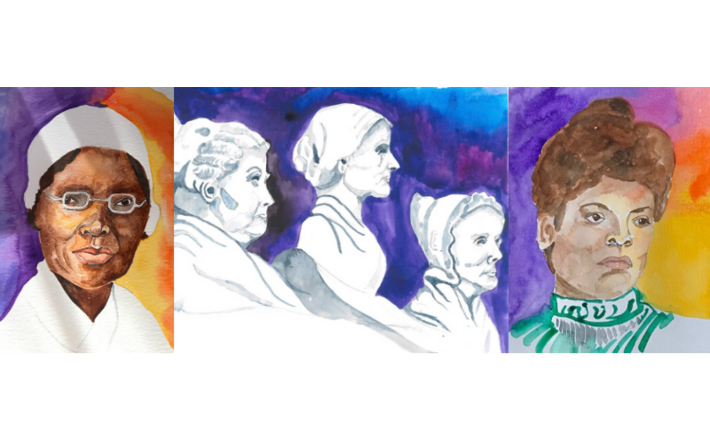Elizabeth Cady Stanton, Sojourner Truth and Ida B Wells: Mothers of the movement for women’s equality
Source: Medium
Many associate the early women’s suffrage movement with suffragist Elizabeth Cady Stanton. Stanton gained prominence with her commitment to abolition and the passing of the 13th Amendment, and quickly recognized the need for a women’s equality movement when barred from many abolition conventions and meetings on the basis of her sex. Partnering with Lucretia Mott, Susan B Anthony, and other progressive women, Stanton organized the first Women’s Rights Convention in 1848, the famed convention would later become known as the Seneca Falls Convention. For the Convention, Stanton wrote the Declaration of Sentiments, modelled after the Declaration of Indepence calling out the inadequacies of the later and its failure to grant the true equality it hinted at. Although an early advocate for abolition, Stanton grew increasingly isolationist in her views on suffrage and equality, actively opposing the 15th Amendment for explicitly excluding women from the right to vote.
As the women’s suffrage movement became increasingly divided over the cross-section of race and gender, Sojourner Truth came to the front, calling for universal equal rights and suffrage. In 1851, at a Women’s Rights Convention in Akron, Ohio, Truth delivered one of her most famous speeches, “Ain’t I a Woman?” Truth called attention to the double-burden women of color face in both gaining civil rights and women’s equality. Although Truth initially worked alongside both Elizabeth Cady Stanton and Frederick Douglass, she distanced herself as Stanton vocally opposed the 15th Amendment and Douglass urged women to wait their turn.
Ida B. Wells carried on Sojourner Truth’s mantle, becoming an avid intersectional activist both for civil rights and women’s equality. While working as a journalist, Wells investigated the systemic lynching of African American men in the south and published several newspaper columns and pamphlets on the pandemic of racial violence. Following death threats for her work, which earned her a posthumous Pulitzer Prize this year, Wells moved from Tennessee to Chicago where she became active in the women’s suffrage movement.
Click here to read the full article published by Medium on 8 May 2020.

Many associate the early women’s suffrage movement with suffragist Elizabeth Cady Stanton. Stanton gained prominence with her commitment to abolition and the passing of the 13th Amendment, and quickly recognized the need for a women’s equality movement when barred from many abolition conventions and meetings on the basis of her sex. Partnering with Lucretia Mott, Susan B Anthony, and other progressive women, Stanton organized the first Women’s Rights Convention in 1848, the famed convention would later become known as the Seneca Falls Convention. For the Convention, Stanton wrote the Declaration of Sentiments, modelled after the Declaration of Indepence calling out the inadequacies of the later and its failure to grant the true equality it hinted at. Although an early advocate for abolition, Stanton grew increasingly isolationist in her views on suffrage and equality, actively opposing the 15th Amendment for explicitly excluding women from the right to vote.
As the women’s suffrage movement became increasingly divided over the cross-section of race and gender, Sojourner Truth came to the front, calling for universal equal rights and suffrage. In 1851, at a Women’s Rights Convention in Akron, Ohio, Truth delivered one of her most famous speeches, “Ain’t I a Woman?” Truth called attention to the double-burden women of color face in both gaining civil rights and women’s equality. Although Truth initially worked alongside both Elizabeth Cady Stanton and Frederick Douglass, she distanced herself as Stanton vocally opposed the 15th Amendment and Douglass urged women to wait their turn.
Ida B. Wells carried on Sojourner Truth’s mantle, becoming an avid intersectional activist both for civil rights and women’s equality. While working as a journalist, Wells investigated the systemic lynching of African American men in the south and published several newspaper columns and pamphlets on the pandemic of racial violence. Following death threats for her work, which earned her a posthumous Pulitzer Prize this year, Wells moved from Tennessee to Chicago where she became active in the women’s suffrage movement.
Click here to read the full article published by Medium on 8 May 2020.